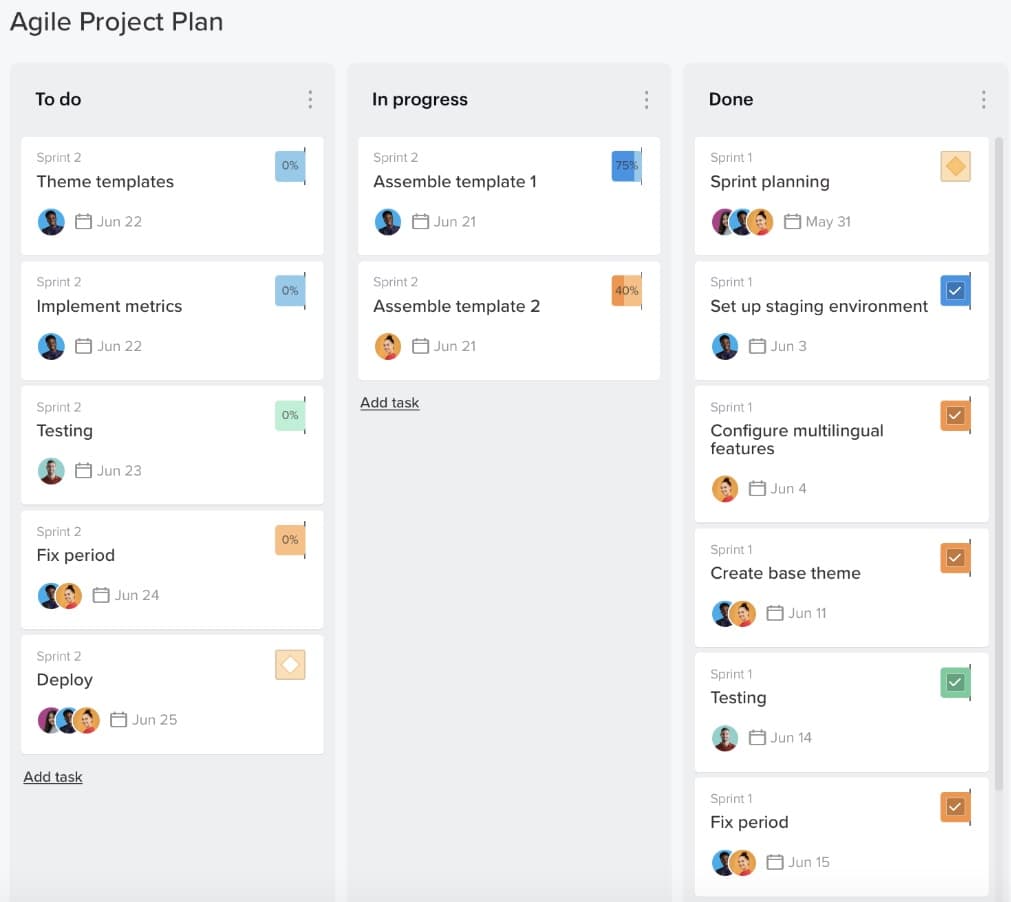[ad_1]
The Agile methodology was developed out of a necessity to handle frequent inefficiencies of extra conventional mission administration approaches, just like the Waterfall method, within the software development industry. However some kinds of tasks may really be burdened by Agile strategies.
There’s no rule that claims you’ll be able to solely decide one and keep it up. So let’s break down the fundamental differences between Agile and Waterfall processes and stroll by learn how to mix the very best of each strategies utilizing a gantt chart.
Understanding Agile and Waterfall processes
Agile project management focuses on iterations through which planning, design, implementation, and testing happen briefly durations of time. As a result of planning occurs all through the Agile mission lifecycle, selections may be extra reactive.
In software development projects, bugs may be caught early and remediated earlier than they develop to develop into larger issues. The premise of this method is to repeatedly plan across the inevitable change requests because the product evolves.
It’s not onerous to see how Agile vs. Waterfall processes differ from one another.
This is the Waterfall course of for a generic mission:

This is the Agile course of for a generic mission:

After I first realized about Agile, I used to be sizzling to attempt it out. I used to be even fortunate sufficient to work with somebody who was a licensed Scrum Grasp. I picked up the fundamentals rapidly, however I discovered {that a} pure Agile method wasn’t working for many of the tasks I used to be engaged on.
Seems, gantt charts are still beneficial for issues like assembly deadlines, managing workloads, and offering project status reports to purchasers and stakeholders—particularly in case your group isn’t 100% Agile.
Widespread drawbacks of Agile mission administration
Among the Agile drawbacks I’ve skilled are frequent ones you and your workforce might encounter whereas utilizing a hybrid Agile approach in a standard group:
- Pure Agile requires a devoted workforce and product proprietor. In Agile, a product proprietor is often your solely stakeholder, and so they’re closely concerned in each determination made alongside the way in which as your product evolves. Except you’re engaged on an inside workforce whose single focus is creating a product, chances are high, you’re making use of Agile ideas to a mission that also has to function inside a standard group. Count on a number of stakeholders—similar to govt management, division managers, and subject material consultants—to muddy up the method.
- Undefined tasks and deliveries might make stakeholders uneasy. In Agile, groups write consumer tales, not necessities. The consumer story format helps the workforce uncover necessities, which evolve and emerge because the mission progresses. This will likely imply the ultimate finish product differs from the unique imaginative and prescient—although stakeholders must be a part of the decision-making course of alongside the way in which. Setting clear course of and function expectations ought to reel in any uneasy emotions.
- There’s no be-all and end-all deadline for ending. Agile works in iterations to repeatedly enhance a product. Whereas this may be good for enterprise, it could possibly develop into irritating for stakeholders who anticipate a tough deadline. With out a clearly defined scope, stakeholders might complain that it looks as if the mission won’t ever finish. Typically, these exact same individuals additionally request changes or wish to add options to the product.
- Your estimates don’t maintain their weight. Dates are fluid with Agile, and it may be onerous to speak timing to stakeholders. You’re extra more likely to encounter stakeholders who have to see a set of milestone dates than ones who can deal with out them. Folks love dates and timing estimates. I haven’t been capable of get round this, and it simply provides extra stress each time I exploit a purely Agile method.
- Burndown charts present dash productiveness—not mission standing. Agile’s nice for blue-sky concepts you construct collectively. However in case you work in a company the place management needs specifics about what they’ll get when or the place issues are within the course of, Agile alone received’t ship. You want an in depth plan that exhibits them the way you’ll get to that date. Gantt charts allow you so as to add structured timelines to dash cycles so you’ll be able to simply replace stakeholders on the standing of a mission.
- Not everyone seems to be an energetic participant. For all the above objects to not develop into an issue, everybody must be very concerned from day one. Whereas that is not a problem for a mission workforce that’s assigned to a single mission, it often doesn’t work out like that for exterior stakeholders. Typically, they’re too busy or don’t have the experience. They merely need the underside line: Is the mission on monitor? Gantt charts can talk this in 30 seconds.

Utilizing gantt charts to handle your Agile tasks
As mission managers, it’s our job to steer the mission from inception by completion. We make selections that have an effect on the completed product on daily basis. Choosing the best method on your mission is not any completely different. Don’t get caught considering it’s a must to use one project management method or one other. After I first made this realization, I seen my tasks ran extra easily.
I not method two tasks the identical approach, however I do start with the identical step. I take all background data accessible on the mission and research it. From this data, I determine which components from both methodologies would work best. This may be based mostly on the attitudes of stakeholders, essential dates we should meet, technical complexity, and workforce composition.
The commonest problem I come throughout is stakeholders’ give attention to timing. Even when a mission lends itself to naturally assume extra Agile-based strategies, not having milestone dates worries most of my stakeholders. That is why I create a modified model of an Agile sprint backlog utilizing gantt charts.
What’s an Agile gantt chart?
An Agile gantt chart is a project planning tool that applies a Waterfall model to an Agile mission by mapping dash duties and dependencies out on a visible timeline. Utilizing a gantt chart for an Agile mission makes it straightforward to trace progress, handle workloads, and maintain stakeholders up-to-date on the work.
Easy methods to use an Agile mission framework with a gantt chart
As soon as I’ve determined which Agile strategies I’m going to make use of in my day-to-day mission administration, listed here are the steps I observe to arrange a fundamental Agile mission with a gantt chart timeline.
1. Create activity objects per characteristic
Below every anticipated iteration, I create one activity merchandise per characteristic. The important thing deviation from a typical gantt chart for a Waterfall-based project is that this chart depends closely on dependencies. All objects in every iteration have a start-to-finish dependency to the testing interval for the iteration. Begin-to-finish dependencies amongst duties are solely given if there’s a technical dependency that will mannequin how my assets would deal with the dash.
All through the iteration, I maintain every day stand-ups in addition to planning and assessment conferences. From these conferences, I can decide which options to maneuver to later iterations. When this stuff are moved round in my gantt chart, the dates transfer robotically too.
Within the gantt chart example under, the highlighted merchandise is a activity that must be moved to a later dash.

2. Transfer and rearrange the dependencies
Under, you’ll be able to see that I’ve moved the duty down and rearranged the dependencies. From my every day stand-ups, I’ve decided that my two assets can work on their assigned duties concurrently, however a few of the different duties which are additionally assigned must transfer again to accommodate this new addition.
So now, the gantt chart for this Agile dash seems to be one thing like this:

It is essential to have online gantt chart software that is versatile and super-easy to make use of. In TeamGantt, you should use drag and drop scheduling to make these modifications on the fly in only a matter of minutes.
3. Use mission boards to deal with every day duties.
In case your workforce doesn’t wish to work in a gantt chart, TeamGantt provides you the choice to view and manage tasks in a kanban board with out having to juggle a number of instruments to deal with the mission.
In Board view, playing cards are tied on to duties in your gantt chart. Crew members can replace and transfer playing cards throughout columns in your board as work progresses—and you’ll relaxation simpler realizing your Agile timeline all the time displays the present standing of the mission.
Right here’s what it might seem like if we monitor our dash duties in Board view based mostly on the Agile gantt chart instance above:

You may customise your mission board columns to suit your workforce or group’s course of. And even create your personal customized board, which lets you handle duties throughout a number of tasks. See how boards work in TeamGantt.
Why gantt charts are helpful for Agile tasks
Now that we’ve proven you an instance of learn how to use gantt charts to handle your Agile tasks, let’s speak concerning the benefits.
Advantages for purchasers and stakeholders
Shoppers and stakeholders actually need the consolation of a plan. Listed below are some benefits of using gantt charts with purchasers:
- Whereas this setup can’t produce fairly progress charts Scrum Masters are used to seeing, I do have a schedule with concrete dates that helps my stakeholders visualize the effort and time every characteristic requires.
- I can share this with my mission workforce, inside stakeholders, and purchasers. This gantt-backlog chart is a direct approach of expressing tasks, milestones, and the anticipated product. When up to date on daily basis following a Scrum, it exhibits mission progress in an intuitive approach.
- Shoppers know when to anticipate elements of the mission to be accomplished, and so they know after they’ll be anticipated to conduct their testing. There is a clear roadmap of how we might attain the ultimate product.
Advantages for mission groups
My workforce members have additionally benefited from utilizing gantt charts to handle our Agile tasks. Listed below are only a few benefits your mission workforce may see too:
- They will see not solely what’s anticipated of them within the upcoming iteration, but additionally an overview of later iterations. Sure duties or options could also be moved all the way down to later sprints or iterations, however the Agile gantt format can even make clear dependencies.
- They will plan for themselves and advise me on how they’d prefer to method implementation. Testers can relaxation simpler realizing a ballpark timeframe of after they’ll be wanted. They will see from the chart what they’re anticipated to check and what to not report bugs on.
- No two tasks are the identical, and this hybrid approach permits me to customise how I run each mission. I can choose strategies which are environment friendly and steadiness my workforce’s preferences with my purchasers’ tendency to prioritize dates.
- I exploit this gantt-backlog mixture to drive conversations with stakeholders on how their requested modifications can have an effect on the general timing. It additionally supplies a useful instrument I can use to coach much less savvy purchasers on design and growth processes.
I’m proud to be a mission supervisor that isn’t outlined with a particular project management methodology. It took me some time to get right here and much more time to simply accept it. However since then, I’ve been capable of get pleasure from larger mission success.

Inquisitive about utilizing a gantt chart on your subsequent Agile mission?
TeamGantt makes it straightforward to create personalized mission plans that match each mission excellent. Our free 30-day Premium trial provides you entry to all of the features you could guarantee tasks end on time and beneath finances, similar to:
- Drag and drop simplicity
- Activity checklist, calendar, and kanban board views
- Straightforward workforce collaboration
- Customized project templates
- Crew availability & workload administration
- Deliberate vs. precise timeline
- Devoted cell app
Better of all, it’s wrapped up in a easy and intuitive interface your workforce and stakeholders can simply navigate.
[ad_2]

